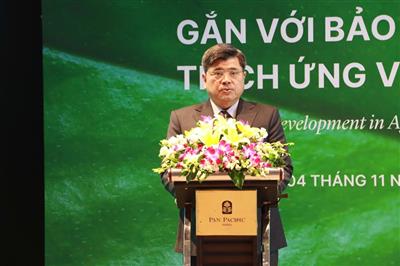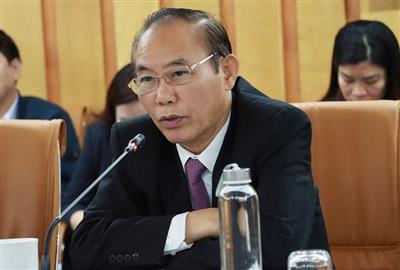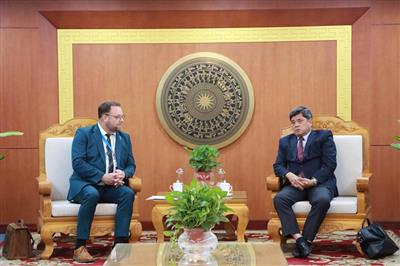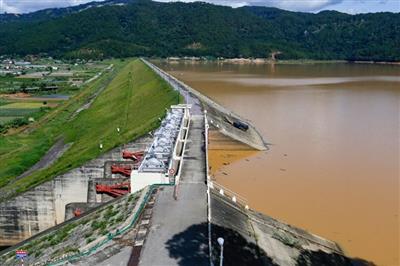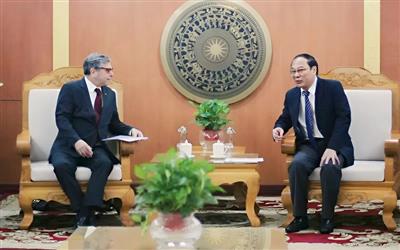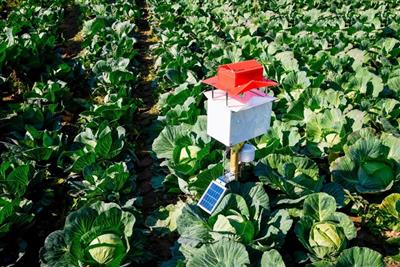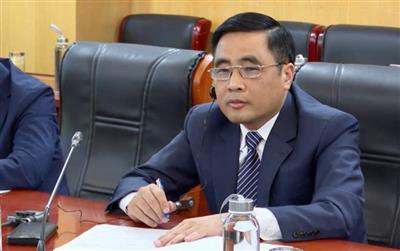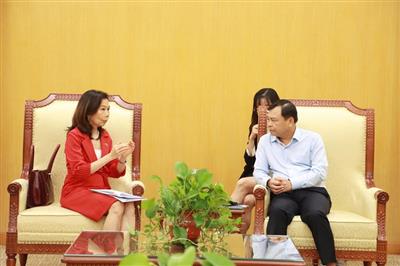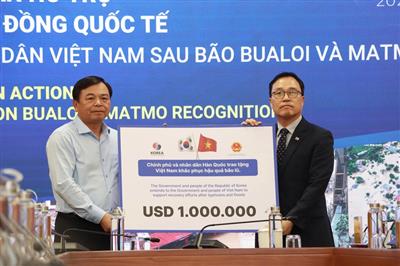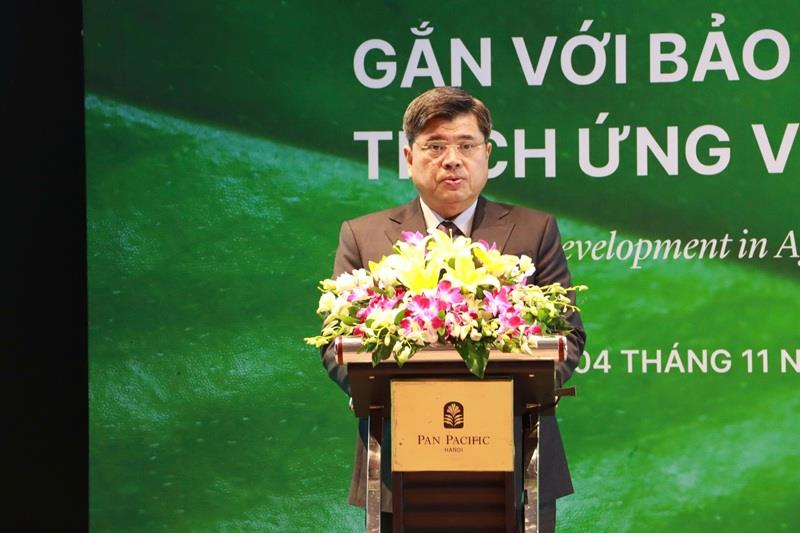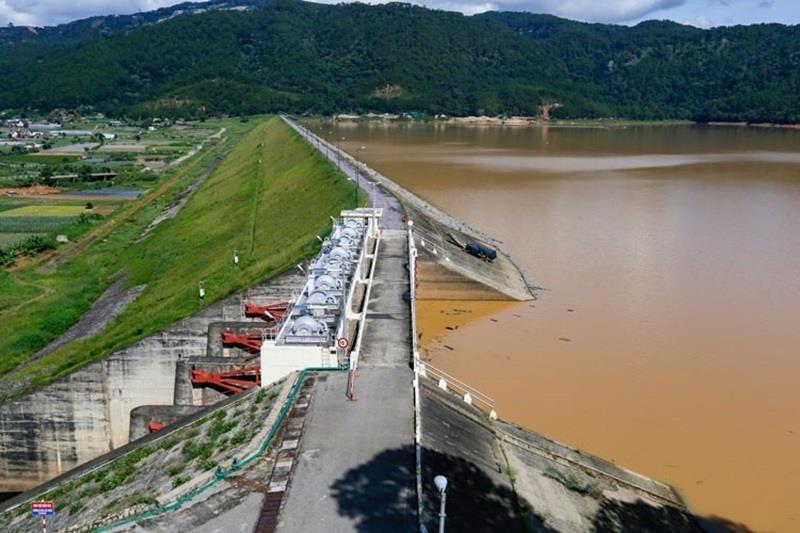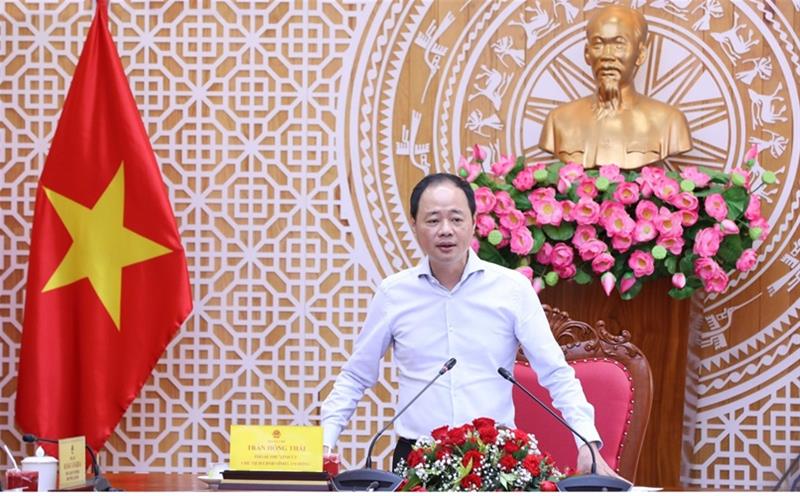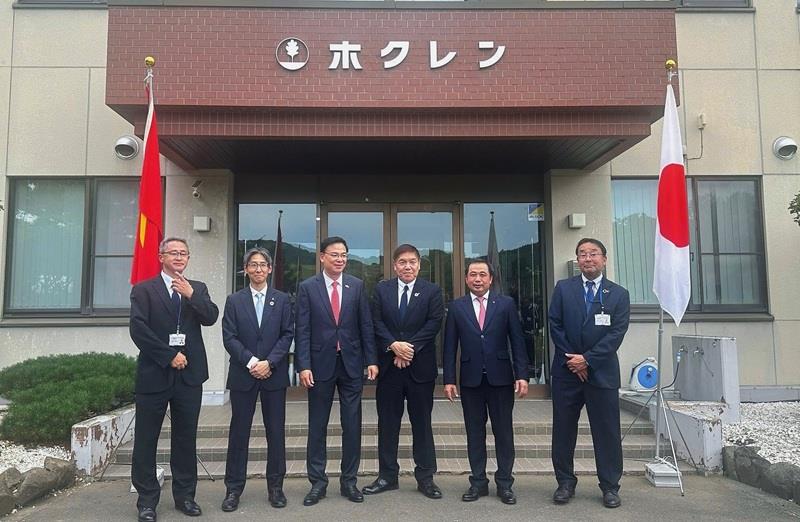
Act today to build resilience for tomorrow
14/10/2025TN&MTThat is the central message of the International Day for Disaster Risk Reduction and the ASEAN Day for Disaster Management 2025. This year’s commemorative activities focus on young people, the future stewards of the nation, with the belief that investing in youth today means laying the strongest foundation for a safer and more sustainable tomorrow. Equipping the younger generation with knowledge, skills, and awareness in disaster prevention and response is an investment in the collective “resilience” of the entire community.
Together, we build a safer future
On the evening of October 13, at Hanoi National University of Education, the Department of Dyke Management and Disaster Prevention and Control under the Ministry of Agriculture and Environment organized a ceremony marking the International Day for Disaster Risk Reduction and the ASEAN Day for Disaster Management 2025. The event brought together representatives from United Nations agencies, international organizations, development partners, and a large number of lecturers and students—spreading the spirit of “Act today to build resilience for tomorrow.”
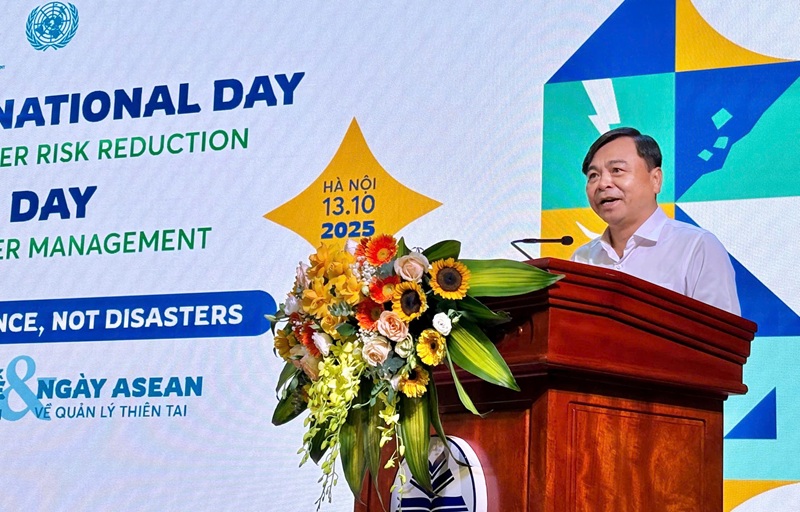
Deputy Minister Nguyen Hoang Hiep delivers the opening remarks, emphasizing that education is not only the foundation of knowledge but also the cornerstone of resilience against natural disasters(Photo: Le Tam)
Speaking at the ceremony, Deputy Minister of Agriculture and Environment Nguyen Hoang Hiep expressed his belief that, with the spirit of “Solidarity – Innovation – Leadership,” Vietnam will join hands with other countries in the region to build a safer and more resilient future.
While the event was taking place, many northern provinces were still suffering severe flooding in the aftermath of recent storms. Within just two months, four successive typhoons had brought record rainfall, submerging vast areas from Cao Bang, Thai Nguyen, and Lang Son to the Red River Delta.
Deputy Minister Nguyen Hoang Hiep emphasized the importance of international solidarity and cooperation in adapting to climate change: “Even at this very moment, that noble international spirit is being illuminated. Tonight, the first relief shipment from Japan has arrived in Vietnam and will be delivered to Bac Ninh tomorrow. At the same time, contributions from Australia are also on their way to the hardest-hit areas. We deeply appreciate and sincerely thank these acts of solidarity and compassion.”
In a context where natural disasters are becoming increasingly complex and financial resources for prevention remain limited, Ms. Pauline Tamesis, United Nations Resident Coordinator in Vietnam, underscored the importance of implementing disaster risk reduction measures strategically. The occasion, she noted, also served as a reminder of the urgent call from United Nations Secretary-General António Guterres, who warned that disaster risks are escalating globally, while critical resources for prevention remain insufficient.

Ms. Pauline Tamesis, UN Resident Coordinator in Viet Nam, highlights youth engagement as key to building community-based disaster and climate resilience (Photo: Phuong Linh)
According to Ms. Pauline Tamesis, the Secretary-General’s message has never been clearer or more urgent: “We must commit resources not only to respond to disasters but to strengthen resilience. For Viet Nam, adopting this strategic approach is fundamental to confronting the growing threats of climate change. We must translate this global priority into decisive national action.”
At the ceremony, Ms. Pauline Tamesis outlined three key actions for disaster risk reduction: strengthening partnerships among stakeholders to improve risk response; building community resilience; and engaging youth in shaping a resilient future. She also reaffirmed the vital role of the Disaster Risk Reduction Partnership, a unique forum through which the Government of Vietnam, UN agencies, international donors, and civil society organizations work together to advance a coordinated approach to disaster risk reduction.
“With Vietnam at the frontline of climate change, we must reinforce governance mechanisms and empower youth and communities. Together, we can build a stronger and more resilient Vietnam,” she affirmed.
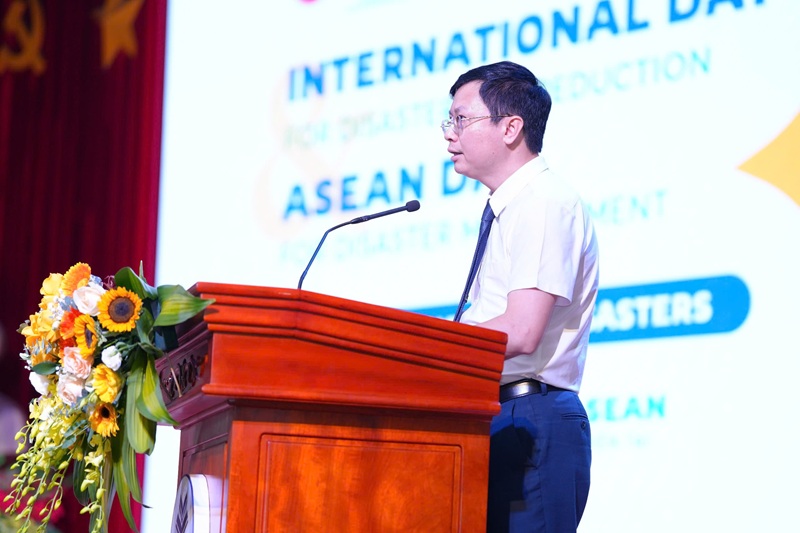
Assoc. Prof. Dr. Nguyen Van Hien, Secretary of the Party Committee and Chairman of the University Council, reaffirms the university’s commitment to research, training, and international cooperation in disaster risk reduction (Photo: Le Tam)
Assoc. Prof. Dr. Nguyen Van Hien, Secretary of the Party Committee and Chairman of the University Council of Hanoi National University of Education, emphasized: “Today reminds us that disaster risk reduction is a long journey that requires the collective effort of all. Our university remains committed to prioritizing resources and creating the best possible conditions to advance research, training, and international cooperation in this vital field.”
Earlier that afternoon, at Noi Bai International Airport (Hanoi), the Department of Dyke Management and Disaster Prevention and Control received the first emergency relief shipment from the Japan International Cooperation Agency (JICA) for affected residents in Bac Ninh Province. Additional aid from the Governments of Australia and Russia, the ASEAN Coordinating Centre for Humanitarian Assistance on Disaster Management (AHA Centre), and other international organizations is expected to follow.
Education: The foundation of disaster resilience
Today’s young generation is not only the beneficiary of disaster prevention policies but also a driving force in building a greener, safer, and more sustainable future.
According to Deputy Minister Nguyen Hoang Hiep, choosing Hanoi National University of Education as the venue was a deliberate decision, reflecting the Ministry’s conviction that education is one of the fundamental pillars for building a resilient future in the face of natural disasters.
Expressing special attention to youth engagement in disaster prevention, Deputy Minister Nguyen Hoang Hiep shared: “I want to extend my deepest concern to those who hold the key to the future—our students, the future educators of the nation. You are not only learners but also sources of inspiration. In your hands lies the future generation of Vietnamese children.”
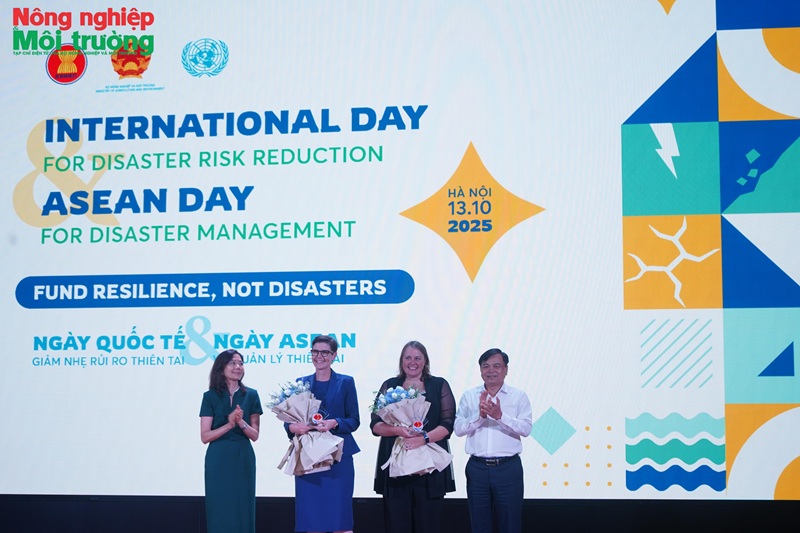
The UK Embassy, WHO, and IOM officially join the Disaster Risk Reduction Partnership during the commemorative ceremony (Photo: Le Tam)
He stressed that even a single classroom lesson integrating disaster awareness, an extracurricular session on survival skills, or a story about post-storm recovery could become a spark that nurtures awareness and plants the seeds of resilience.
“You are the living bridge between academic knowledge and real life, between today’s lecture halls and tomorrow’s communities. Write the story of a resilient Viet Nam with your own passion and intellect,” the Deputy Minister urged.
Through a series of initiatives such as the “Understanding disasters – Building the future” campaign, the “Green generation 2025” contest, and the “Green lesson plan – Safe future” program, thousands of students nationwide have actively participated in exploring, innovating, and spreading the message: “Investing in resilience today ensures safety tomorrow.”
From classroom projects integrating disaster awareness to technological innovations in early warning systems, or creative art pieces promoting recovery and hope, Vietnam’s youth are not standing on the sidelines—they are actively driving community awareness and turning knowledge into action.
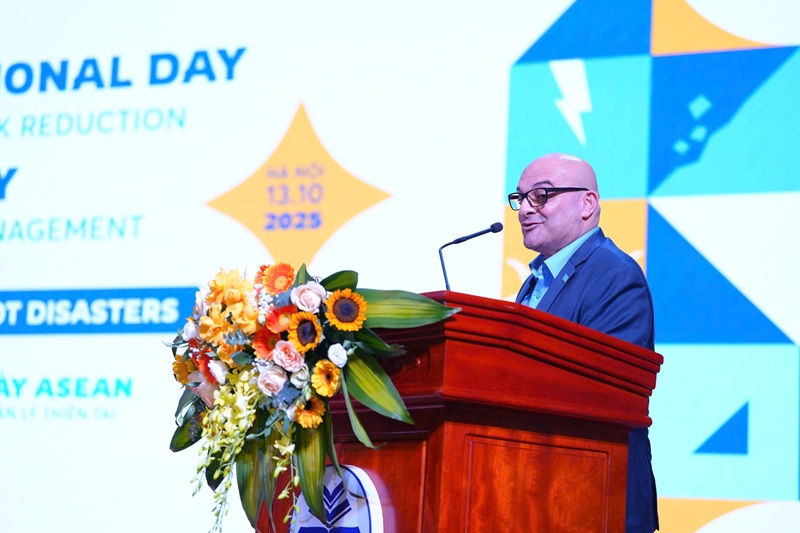
Mr. Ziad Nabulsi, Acting Representative of UNICEF in Viet Nam, underscores that investing in education is the most sustainable path to strengthening disaster resilience (Photo: Le Tam)
Mr. Ziad Nabulsi, Acting Representative of UNICEF in Vietnam, affirmed: “Investing in education is the most sustainable investment we can make to combat climate change and reduce disaster risks. When a child learns how to stay safe in danger, that knowledge lasts a lifetime, and it spreads to families and communities. Each of you holds that power: to turn knowledge into protection, awareness into resilience, and compassion into action.”
He expressed confidence that a resilient Vietnam is one where schools remain safe and learning continues during emergencies; teachers are equipped to provide disaster risk reduction education; and children’s voices help shape national climate and disaster policies.
With energy, creativity, and a deep sense of social responsibility, today’s young generation is becoming the firm foundation for a resilient Vietnam, ready to confront disasters and move toward a sustainable future.
Khanh Linh - Ngoc Huyen




